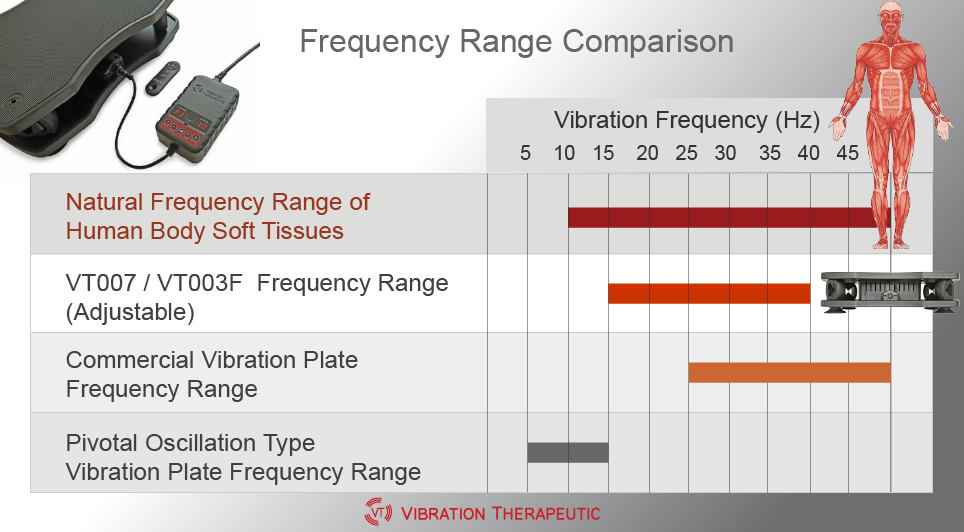Vibration Plate Frequency — Definition & Influences
The frequency of a vibration plate refers to how many times it moves up and down in one second. The unit of frequency is Hertz (Hz).
For example, if a vibration plate operates at 15 Hz, it means the platform completes 15 upward and downward movements per second.
Page Content Index
- Vibraiton Frequency Illustrated
- Frequency of Linear Vibration
- Frequency of Pivotal Oscillation
- What is Speed Level?
- Influences on Human Body
- Natural Frequency & Resonance Effect
- Natural Frequency of Humany Bodyand Tissues
- Linver vibration vs. Pivotal Oscillation
- Vibration Plate Model VT007 and VT009
Vibration Frequency Illustrated
Frequency of Linear Vibration
The animations below compare two linear vibration plates, one vibrates at 1Hz, the other vibrates at 4Hz.
 |
 |
| Frequency = 1Hz Vibration plate move up-and-down 1 time in a second. |
Frequency = 4Hz Vibration plate move up-and-down 4 time in a second. |
These animations are slow motion for demonstration purpose. In reality, linear vibration plates usually vibrate at the frequency range between 15Hz and 40Hz.
Frequency of Pivotal Oscillation
The animations below compare two pivotal oscillation plates, one vibrates at 1Hz, the other vibrates at 3Hz.
 |
 |
| Frequency = 1Hz Vibration plate move up-and-down 1 time in a second. |
Frequency = 4Hz Vibration plate move up-and-down 3 time in a second. |
These animations are slow motion for demonstration purpose. In reality, pivotal oscillation plates usually vibrate at the frequency range between 5Hz and 15Hz.
Frequency is a simple and accurate expression of how fast a vibration plate vibrates.
What is Speed Level?
Many manufacturers use speed level instead of frequency to represent the operating rate of their vibration plates. However, speed level is an arbitrary, model-specific measure defined by each manufacturer. It does not indicate the actual vibration frequency and may lead to misunderstanding.
Speed level explained with an example
Manufacturer A produces a vibration plate with a maximum frequency of 15 Hz and programs 99 speed levels into the device. Manufacturer B copies the same vibration plate but programs 180 speed levels instead. As a result, two identical machines are marketed as having 99 speeds and 180 speeds, respectively, which is confusing.
It also makes little sense to include 99 or even 180 incremental speed levels for a vibration plate that moves up and down only 15 times per second, making the control unnecessarily complicated and awkward to use.
Influences on Human Body
Vibration frequency is a key parameter of a vibration plate. Together with amplitude, they determine the vibration intensity and the pattern of stimulation applied to the user.
Natural Frequency & Resonance Effect
When vibration transfers from one object to another, if the vibration frequency of the source (vibration plate) matches the natural frequency of the target object (our body or tissues), the target object vibrates with maximum amplitude. This phenomenon is called resonance.
The natural frequency of an object is determined by the object's mass and rigidity. It is directly proportional to rigidity and inversely proportional to mass — meaning that heavier and more flexible objects have lower natural frequency, while lighter and more rigid objects have higher natural frequency.
Natural Frequencies of Body and Tissues
The natural frequencies of the human body and its tissues vary due to differences in weight, rigidity, structural flexibility, posture, and vibration direction.
Understanding the natural frequencies of the human body and its tissues helps explain how the body responds to vibration stimulation. The whole body resonates most strongly at frequencies between 5 Hz and 10 Hz, while muscle tissues respond more intensely within the 10 Hz to 40 Hz range.
Linear Vibration vs. Pivotal Oscillation - Influences of Frequency -
Linear vibration plates and pivotal oscillation plates are two distinct types of vibration machines. They differ not only in their movement patterns but also in their operating frequency ranges. As a result, the human body and its tissues respond differently to each type of vibration.
| Linear Vibration Plates | Pivotal Oscillation Plates |
| Frequency: 15 - 40 Hz Amplitude: 1-3mm |
Frequency: 5 - 15 Hz Amplitude: 8-10mm |
| Resonance effect on skeletal muscles | Resonance effect on the whole‑body |
| Does not shake the body high but effectively induces skeletal muscle contractions. The muscles are tense due to contraction. | Shakes the body vigorously but causes less muscle contraction. Muscles stay loose and swing with the movement. |
A linear vibration plate causes less overall body movement but more effectively works the skeletal muscles through inducing muscle contractions. In contrast, a pivotal oscillation plate produces greater whole-body motion with relatively less muscle activation.
Vibration Plate Model VT007 & VT009
Vibration plate models VT007 and VT000 are designed with a frequency range that aligns with the natural frequency of living skeletal muscles. This design maximizes vibration effectiveness by achieving optimized muscle stimulation through the resonance effect.
